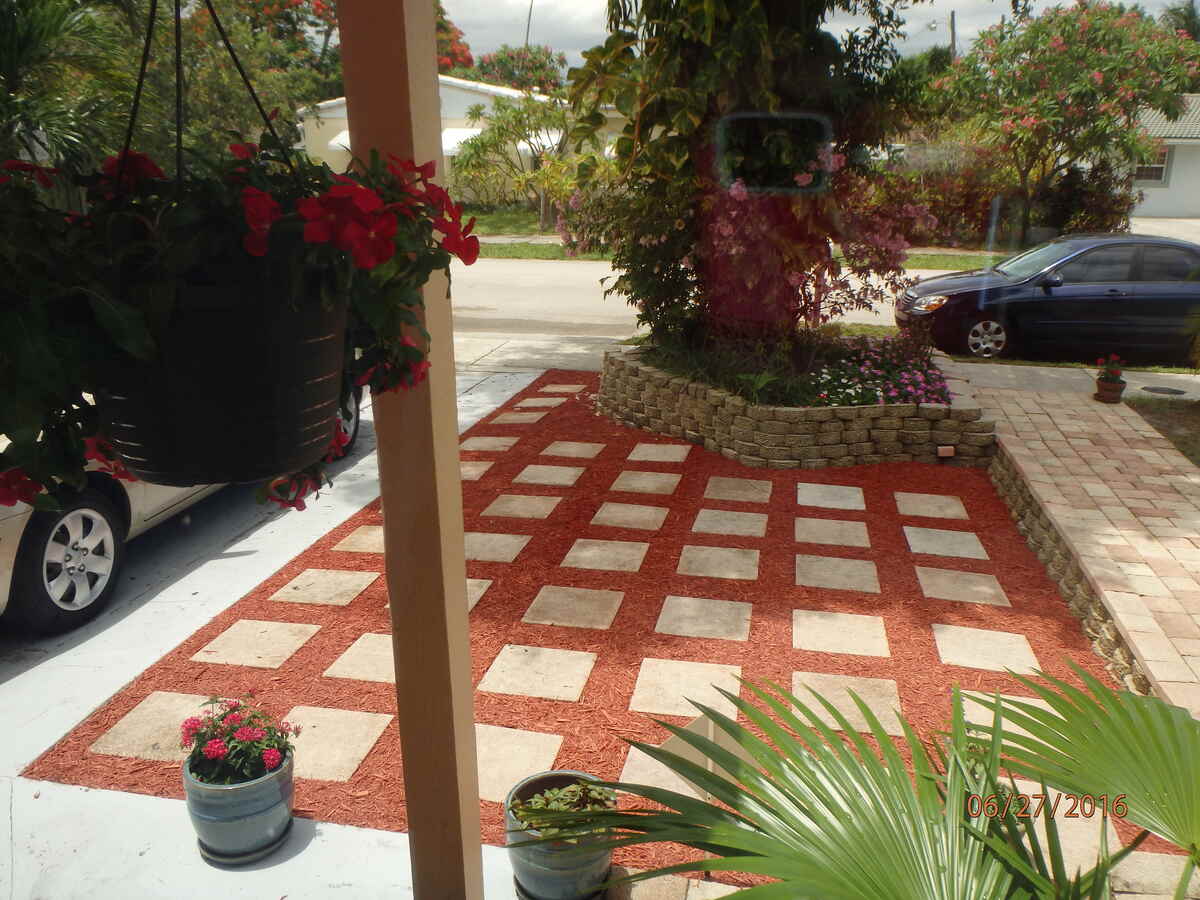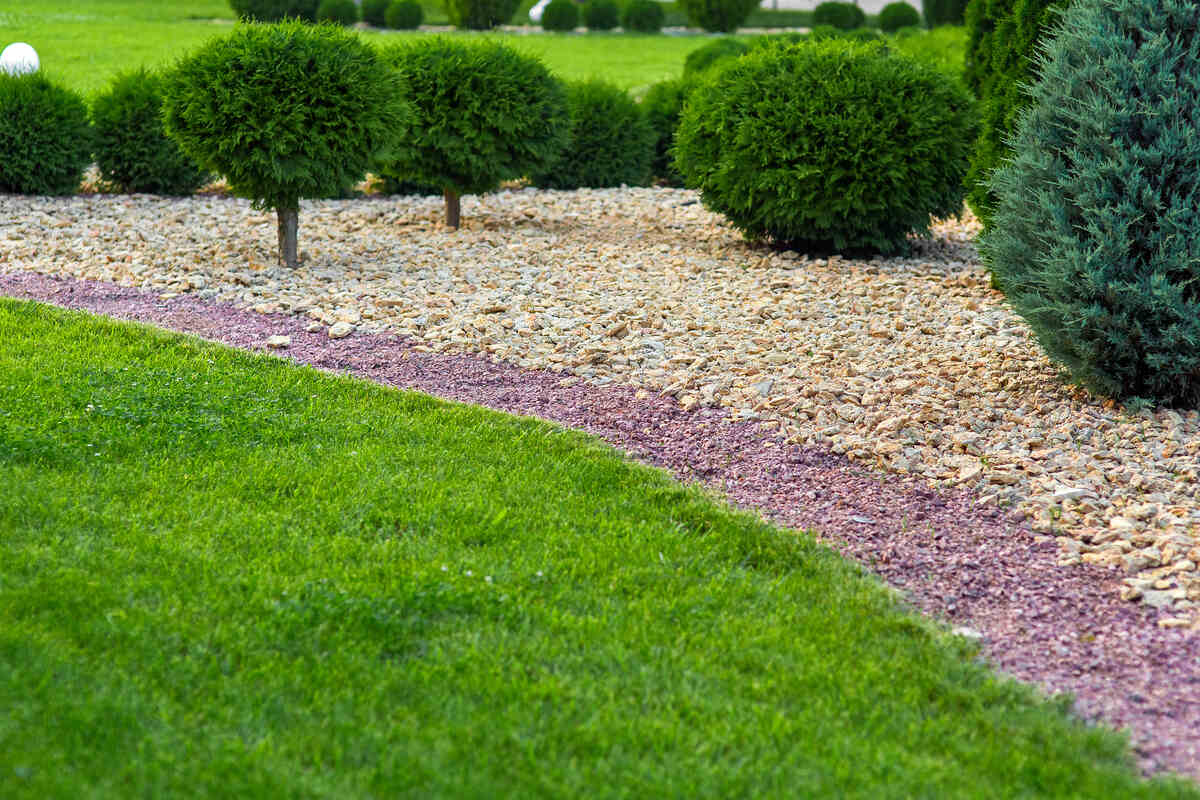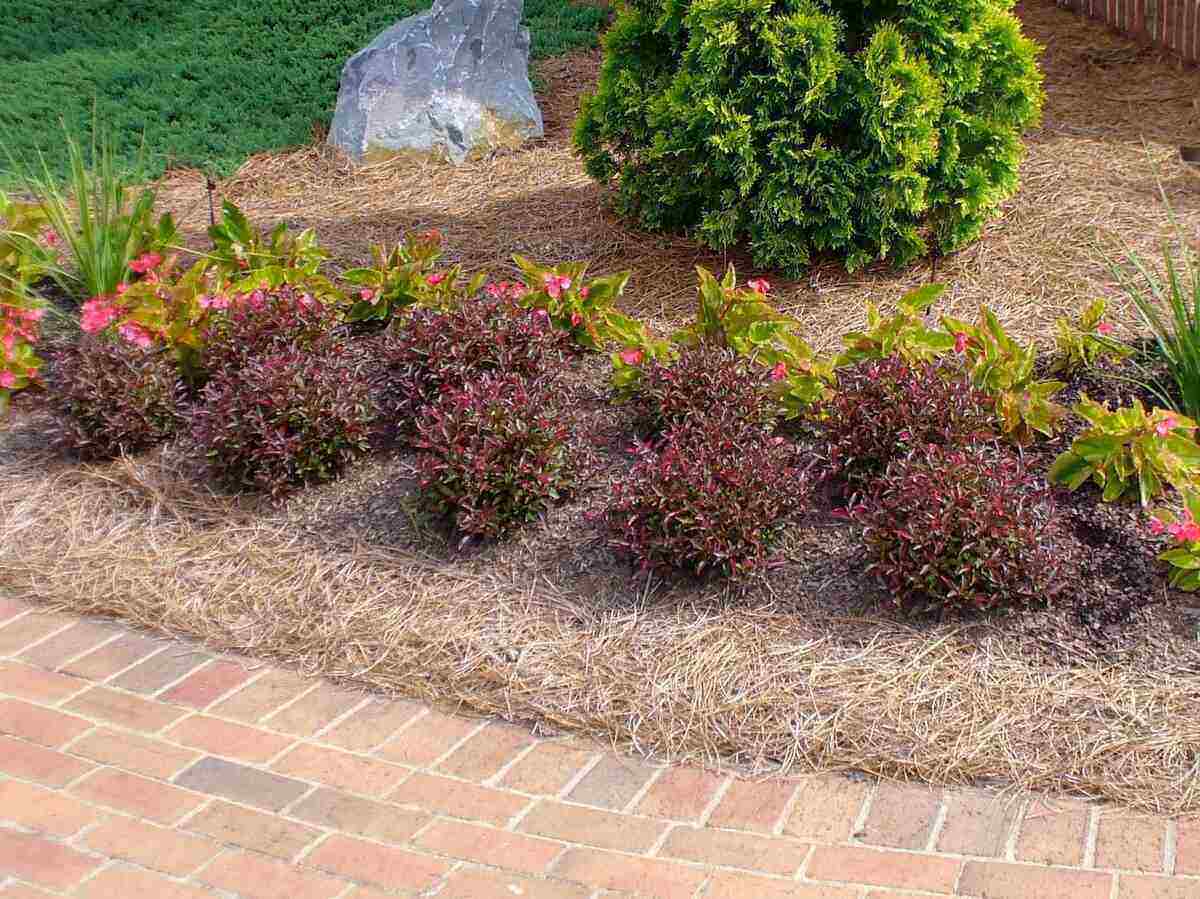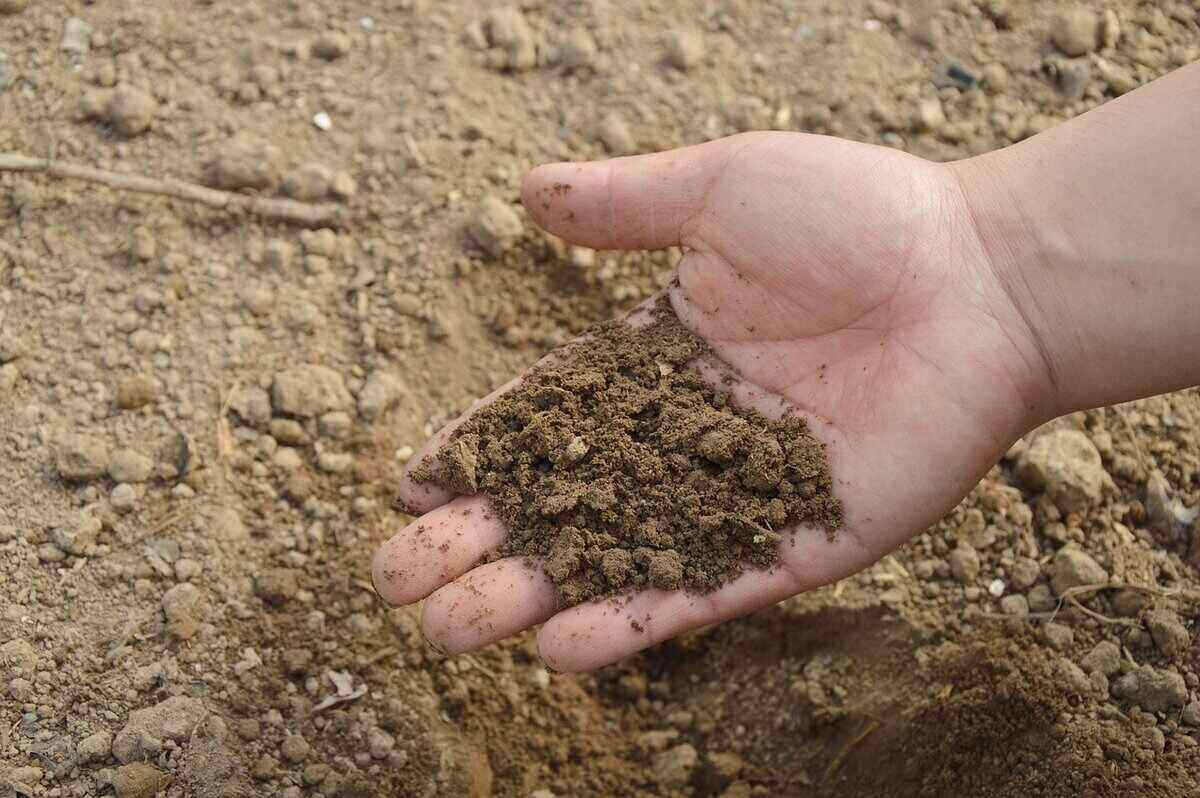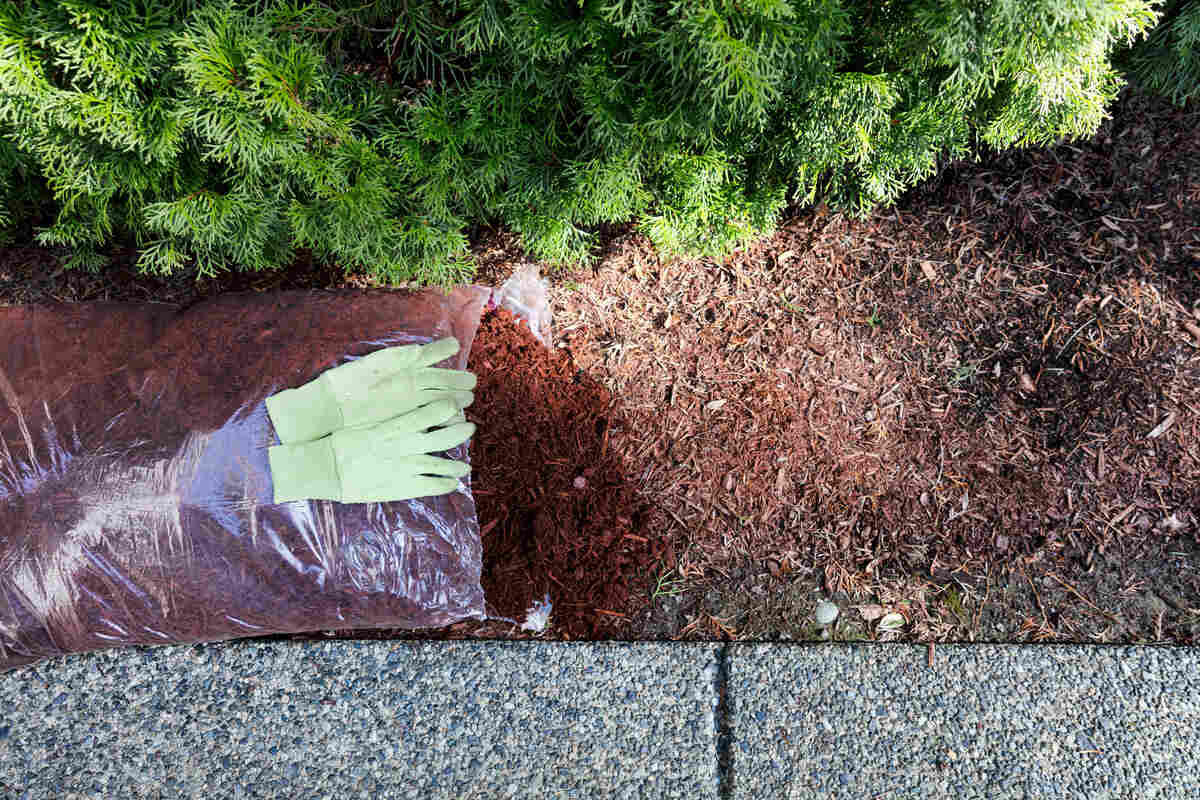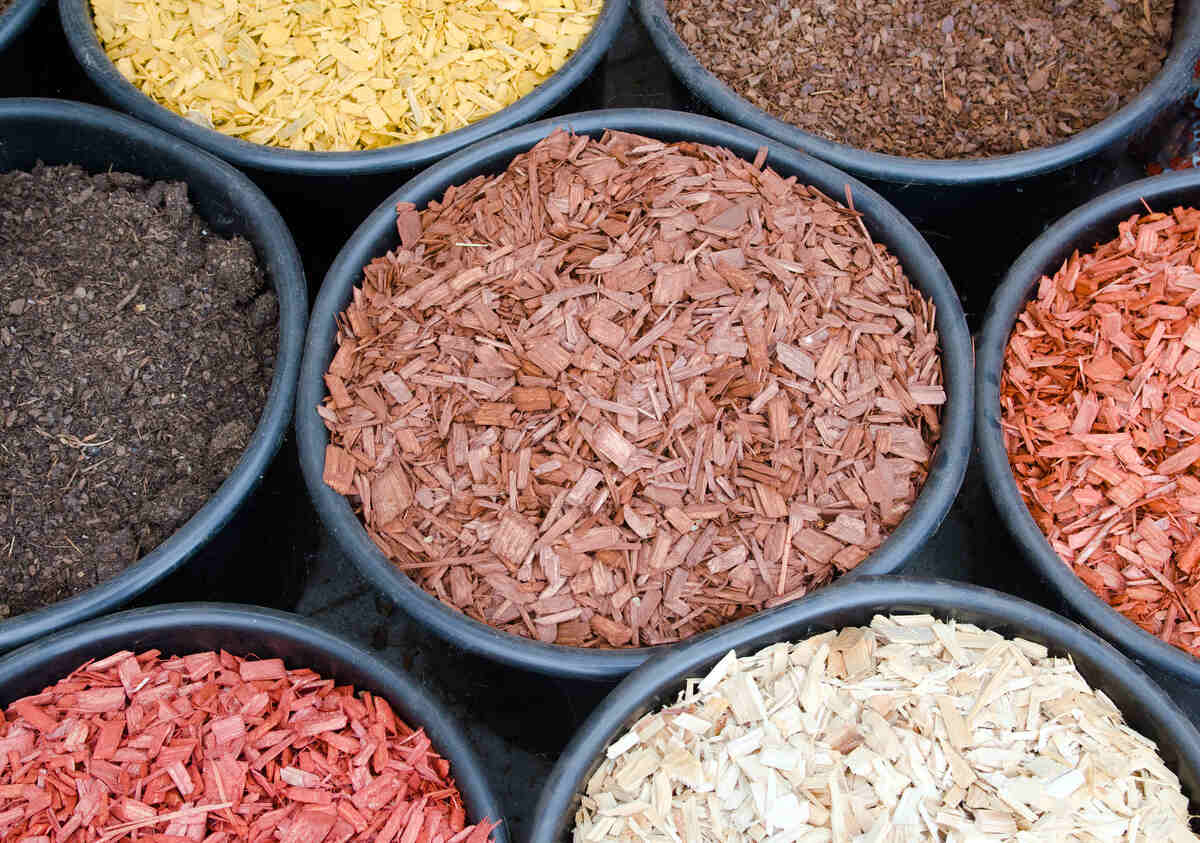
Organic mulch is the all-natural watchdog of your soil. Wood chips, pine needles, and grass clippings are types of organic mulch that minimize compaction, prevent erosion, and release beneficial nutrients back into the ground.
We’ll explore the nine best types of organic mulch, looking into their pros, cons, and where they are best used in your landscape.
What Is Organic Mulch?
Organic mulch comes from natural plant materials, including dry leaves and grass clippings. On the other hand, inorganic mulch is made of non-plant materials like rocks, plastic, and rubber.
Organic mulch breaks down over time, slowly releasing beneficial nutrients back into the soil. It prevents soil compaction, enhances water retention during droughts, and improves the general aesthetic of your lawn. Let’s dive into the nine best types of organic mulch for your lawn, landscaping, and garden.
See Related:
9 Types of Organic Mulch
1. Tree Bark

Bark is one of the best types of organic mulch. It is a natural product of both lumber and paper industries. Tree bark decomposes slowly, so it’s a great option if you’re looking to minimize mulch replacement. It is also highly effective in reducing soil compaction, allowing the plant roots to comfortably consume water and nutrients.
Similar to other types of mulch, bark will consume nitrogen from the soil when decomposing, so you’ll need to apply fertilizer post-mulching to maintain the plants’ health.
Bark mulch takes two forms: chunks and shredded. Bark chunks are more prone to washing away than their counterparts. Shredded bark needs more frequent replacement than bark chunks, but performs extremely well on sloped lawns and is great at suppressing weed growth.
Tree bark is best for: Annual and perennial gardens, slopes, trees, and shrubs.
Pros:
- Long-lasting
- Available in a variety of colors
- Strongly resists weed growth
- Resistant to soil compaction and erosion
Cons:
- Large chunks of bark can hinder new plant growth
- May form a crust that keeps water from penetrating the soil
- Can attract unwanted insects such as roaches
See Related: How to Mulch Around Trees (The Right Way)
2. Wood Chips
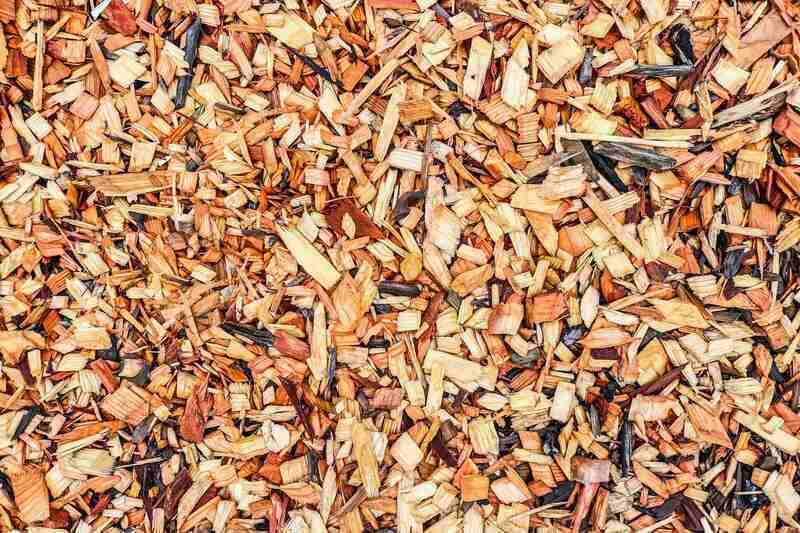
Not only are wood chips aesthetically pleasing, but they suppress weeds and prevent soil erosion. Generally speaking, wood chips contain a mixture of tree bark, leaves, and inner wood. This organic diversity helps improve the soil quality and your plants’ health. For long-term benefits, it’s best to purchase large wood chips rather than small ones that break down much quicker.
To provide additional nutrients to your new garden planting, you can spread a layer of compost (1 or 2 inches deep) over the soil and top it off with a layer of wood chips. This will help settle the compost and work its magic to boost plant growth.
Wood chips can be purchased from local garden centers, local arborists who specialize in tree removal, or acquired at municipal waste facilities.
Wood chips are best for: Perennial flower landscape plantings, around water gardens.
Pros:
- Long-lasting
- Won’t blow away easily
- Will not compact readily
- Doesn’t transfer heat to soil
- Excellent around water gardens and perennial gardens
Cons:
- Can develop a crust that reduces the soil’s water absorption
- Can attract pests such as termites
- May contain harmful pesticides
See Related: Where to Get Free Mulch
3. Pine Needles
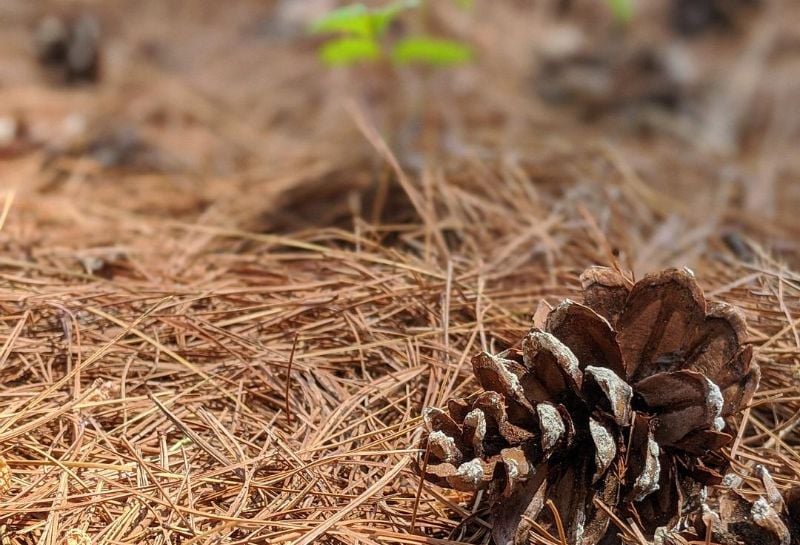
Pine needles are a light, airy type of organic mulch that add beauty and fragrance to your lawn. Similar to tree bark and wood chips, they play a huge role in reducing soil erosion and compaction. Additionally, they have a long lifespan and won’t form a water-resistant crust like the preceding mulches.
Afraid pine needles will contribute to the soil’s acidification? That’s actually a gardening myth. So don’t worry too much about pine needles adding acid in your soil, as the pH level will neutralize once the needles naturally break down.
Pine needles are best for: Annual and perennial gardens, vegetable gardens.
Pros:
- Prevent soil compaction
- Boost your lawn’s curb appeal
- Very affordable; free if you collect them yourself
- Reduce the need for lawn aeration
- Have a desirable fragrance
- The interlocking needles are excellent at preventing erosion
- Unlike wood and bark mulches, pine needles won’t develop a water-resistant crust
Cons:
- Flammable, can be a fire hazard
- If applied too deeply, they can prevent water infiltration to the soil
4. Straw
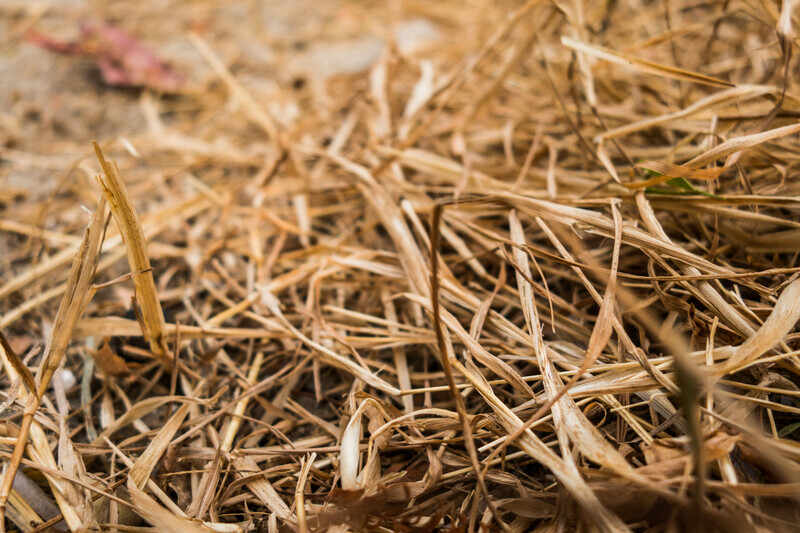
Straw contains fewer weeds and crop seeds than hay, so it’s preferred over hay as an organic mulch. Straw insulates the soil, provides good weed resistance, and helps conserve soil moisture. It will decompose rather quickly, though, so regular replacement is necessary to maintain a proper mulch depth.
Straw can become a habitat for small rodents, such as field mice, which is one major downside to this mulch type. Consider installing a garden fence made of hardware cloth to keep rodents away from your favorite veggies.
Straw mulch is best for: Vegetable gardens, annual gardens, trees and shrubs.
Pros:
- Resists soil compaction
- Affordable
- Helps regulate soil temperature in winter
- Readily available
Cons:
- Can blow away easily
- Attracts unwanted rodents to your yard
- Potential fire hazard
- Not as attractive as pine needles
- Frequent reapplication
5. Leaves
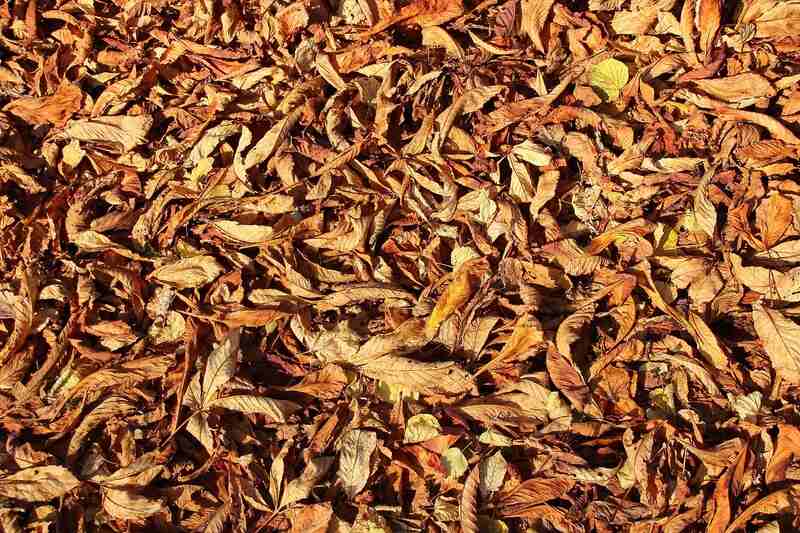
To be used as organic mulch, leaves should be partially decomposed and shredded. This prevents them from creating a thick, wet mat on the garden soil. Once the decomposed leaves break down over time, the beneficial nutrients will flow back into the soil and aid in your plants’ growth.
Dry leaves are another option if you don’t have access to partially decomposed leaves. However, they blow away quite easily and cannot prevent soil compaction. Overall, partially decomposed are your best bet.
On an important note, avoid using leaves from black walnut trees, as they contain juglone. This organic compound may cause issues for many garden plants, including peppers and tomatoes.
Leaves are best for: Vegetable gardens, annual flower gardens, and overwintering pollinators.
Pros:
- Quick decomposition to feed the soil
- Safe haven for beneficial insects in winter
- Easy to access
- Affordable
Cons:
- Potential fire hazard
- Can attract unwanted rodents
- Poor resistance to soil compaction
- Wet, unshredded leaves can form a mat on the soil
6. Aged Sawdust

Acid-loving plants love sawdust, especially if it’s aged. Aged sawdust is also affordable and excellent at preventing weeds from spreading across your landscaping beds.
One major flaw of aged sawdust is its high consumption of nitrogen during decomposition. Your soil and plants may take a huge hit if sawdust mulch isn’t complemented with fertilizer. You can mix nitrogen-rich fertilizer with the sawdust or apply it as a post-mulching treatment.
Aged sawdust is best for: Acid-loving trees and shrubs, and around walkways.
Pros:
- Suppresses weeds
- Affordable
- Boosts growth of acid-loving plants
Cons:
- Consumes a lot of nitrogen during decomposition
- Can attract termites
- Blows away easily
- Compacts easily
- Can form a mat that reduces water absorption
Pro Tip: Even after applying fertilizer with mulch, it’s best to test your soil pH to check for areas with low nitrogen levels. Here’s a guide on How to Test the Soil pH of Your Lawn.
7. Grass Clippings
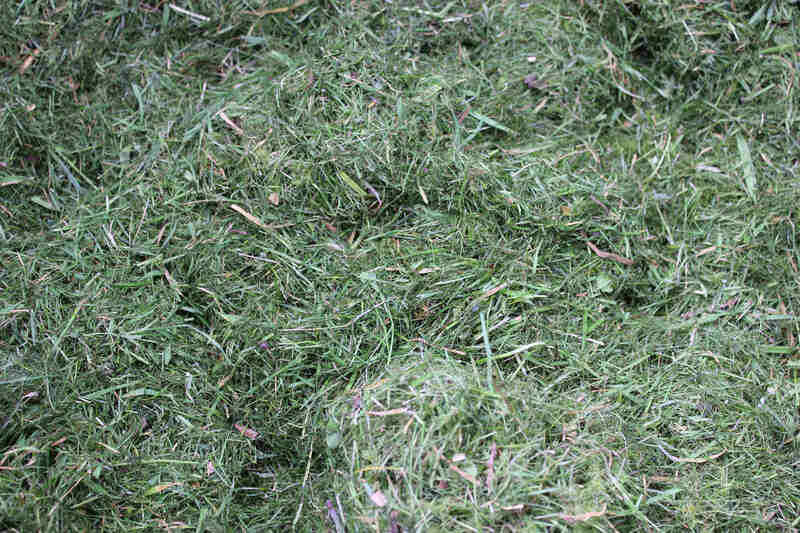
Grass clippings are a popular type of organic mulch, readily available from your own lawn. You can leave them on your lawn to act as a nutrient-rich mulch or apply the clippings to your garden soil.
If you add grass clippings to your garden, don’t use freshly cut clippings straight from your grass catcher bag. When used as mulch, grass clippings should be dry. Wet, freshly cut grass clippings can impede water absorption, give off a bad odor, and form a mat that encourages soil compaction.
To get the best out of dry grass clippings, apply them loosely and in thin layers to reduce matting and soil compaction. If you’ve recently used herbicides on your lawn, wait at least three cuttings before using the clippings as mulch.
Grass clippings are best for: Annual flower and vegetable gardens, perennial garden beds, turfgrass.
Pros:
- Available for free
- Eco-friendly
- Fast decomposition to add nutrients to the soil
- Easy to apply
Cons:
- Low resistance to compaction
- May contain herbicides
- Can form a mat that limits your soil’s water absorption
- Wet clippings may spread foul odors and lawn diseases
See Related:
8. Compost
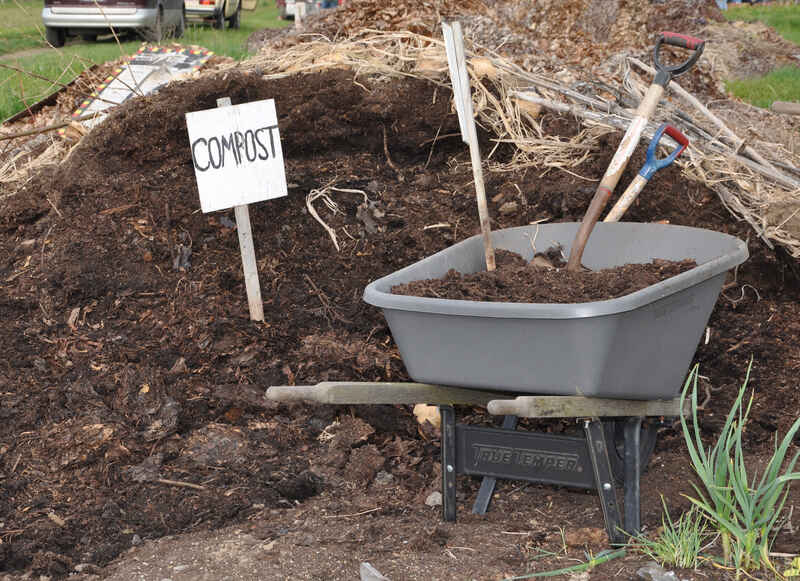
Compost is an excellent source of nutrients for your plants. It’s basically a mixture of decomposing organic material, which often includes fallen leaves or food scraps. Compost protects your plants’ roots, insulates the soil, and improves its texture.
Compost is also a source of food for beneficial bacteria, worms, and fungi. These organisms speed up the breakdown of organic matter and release chemicals that prevent lawn diseases from spreading.
Compost can be used as a soil amendment or mulch, depending on how you apply it to your soil. Tilling compost into the garden bed as an amendment helps improve the soil’s structure and drainage. On the other hand, you can achieve the benefits of mulch by applying a top layer of compost over the soil’s surface.
But here’s the biggest advantage: You can make your own compost. To reap the benefits of this DIY task, learn how to start composting in your own backyard.
Compost is best for: Vegetable beds, flower beds, and trees.
Pros:
- Easy to make yourself
- Reduces soil compaction
- Rapid breakdown to quickly release nutrients
- Prevents soil erosion
- Reduces the spread of plant disease
- Can also be used as a soil amendment
Cons:
- Can attract pests such as rats
- May release foul odors
- Not effective in suppressing weeds
- Takes time to decompose before getting used as mulch
9. Newspaper or Cardboard

If you’re looking to get rid of old newspapers or cardboard boxes, don’t throw them away just yet. Repurposing cardboard and newspaper is a great way to recycle and provide your lawn with organic mulch. But how so?
Natural-made papers and cardboards are effective in maintaining moisture levels in the soil and preventing weed growth. On an important note, avoid using the colorful inserts in newspapers. They degrade slowly and might contain toxic dyes.
Fun Fact: The ink used on newspapers is organic. And since newspaper is made from trees, it’s an organic mulch.
Newspaper and cardboard are best for: Trees, pathways, and new garden or flower beds.
Pros:
- Accessible
- Great way to recycle
- Maintains moisture levels in soil
- Prevents weed growth
- Inexpensive
Cons:
- Cardboard can take up too much space
- Highly colorful newspapers contain toxic dyes and should not be used
- Can be a fire hazard
- Rodents such as mice might use the material to build nests
FAQ About Organic Mulch
If you’re planning to use wood chips as mulch, some local arborists and utility companies give away wood chips for free. If you happen to live near them, there’s no harm in asking. Your city government is another potential source for free wood mulches.
Grass clippings and other common organic mulches can come from as close by as your own lawn. If you have pine trees, you can collect pine needles from your yard. Leaves are also available right on your own property. But most people buy pine needles, straw, bark, and other organic mulches at local home and garden stores or online.
Finally, newspapers may be delivered to your house every morning. Instead of throwing them in the recycling bin, spread them in your garden as beneficial, organic mulch.
On average, the cost of organic mulch ranges from $20 to $110 per cubic yard, with pine straw on the low end and cypress mulch at the other extreme (materials only). If you’re picking up a few bags at the store, expect to pay from $3.25 to $6.50 per bag.
In general, organic mulch is more affordable than inorganic mulch in the short term, but more frequent applications may mean higher costs in the long run.
The best time to apply organic mulch around trees and gardens is in the spring. This is when soil temperature and moisture are at their best levels to encourage proper plant growth. Generally, organic mulch needs to be replaced every 1 or 2 years to maintain a healthy, weed-free landscape.
Signs organic mulch needs replacement:
• Mulch color is fading
• Weeds are sprouting through the mulch
• Mulch is fading and decreasing in volume
• You notice fungal diseases or pest infestations
For more on this topic, check out our article: How Often Should You Replace Mulch?
Stacking up large amounts of organic mulch around your tree or on your garden bed will do more harm than good. Here are some of the main issues resulting from overmulching:
• Oxygen levels drop in the soil
• Rodents such as mice may dig into the mulch and seek shelter
• Overmulching around trees may result in trunk diseases and their gradual death
See Related: How Deep Should Mulch Be?
Hire an Expert for Professional Lawn Care
Organic mulch is affordable, readily available, and full of nutrients to improve your soil’s quality. You have various options to choose from, depending on your yard’s needs and the overall aesthetics of your landscape. Pine needles, tree bark, and wood chips have more pros than cons, so you can’t go wrong with choosing any of these organic mulches.
To save yourself the time and headache of hauling mulch to and from the store, hire a local landscaping pro to apply your choice of mulch in your flower and perennial beds and around trees in your lawn.
The best organic mulch for your lawn? Grass clippings. After mowing the lawn, leave grass clippings on the lawn to decompose and fertilize the soil. Don’t have time to mow? Hire a lawn care pro near you to cross this lawn chore off your list.
See Related:
Main Photo Credit: Fiedels / Adobe Stock / License
